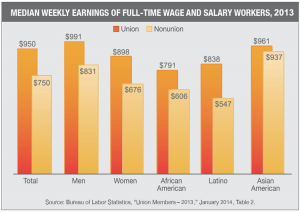General Information About Unions
A union is a group of workers who form an organization to gain:
- Respect on the job
- Better wages and benefits
- More flexibility for work and family needs
- A counterbalance to the unchecked power of employers
- A voice in improving the quality of their products and services
What is a labor union?
 A labor union is an organization of workers who work to achieve the common goals as stated above. The labor union, through its leadership, bargains with the employer on behalf of union members (rank and file members) and negotiates labor contracts with employers.
A labor union is an organization of workers who work to achieve the common goals as stated above. The labor union, through its leadership, bargains with the employer on behalf of union members (rank and file members) and negotiates labor contracts with employers.
This may include the negotiation of wages, work rules, complaint procedures, rules governing hiring, firing and promotion of workers, benefits, workplace safety and policies. The agreements negotiated by the union leaders are binding on the rank and file members and the employer and in some cases on other non-member workers.
Unions are about a simple proposition: By joining together, working women and men gain strength in numbers so they can have a voice at work about what they care about. They negotiate a contract with their employer for things like a fair and safe workplace, better wages, a secure retirement and family-friendly policies such as paid sick leave and scheduling hours. They have a voice in how their jobs get done, creating a more stable, productive workforce that provides better services and products. Always adapting to the challenges of our nation’s evolving workforce, unions are meeting the needs of workers in today’s flexible and nontraditional work environments. Because no matter what type of job workers are in, by building power in unions, they can speak out for fairness for all working people in their communities and create better standards and a strong middle class across the country.
History
The traces of trade unions' existence could be traced from the eighteenth century. The rapid expansion of industrial society drew women, children, rural workers and immigrants to the work force in larger numbers and in new roles. This pool of unskilled and semi-skilled labor spontaneously organized in fits and starts throughout its beginnings and would later be an important arena for the development of trade unions.
What is Apprenticeship?
Apprenticeship is a structured system of training designed to prepare individuals for skilled occupations. It combines on-the-job training under the supervision of experienced journey workers with related classroom instruction.
If you want to be assured of the Highest Quality for your next construction project - Look to us!
Our membership is made up of thousands of craftsworkers across NorthEast Wisconsin
who are dedicated to providing the best quality in the construction industry. You cannot find a workforce with a higher level of skill and training than with our contractors.
We are proud to lead the industry in training to meet the ever changing technology in the industry. We communicate with our contractors, project owners and elected officials to keep current with changing construction needs. We continue to monitor PSC hearings, school board, and local government proceedings to stay in touch with evolving projects, many times lending support. We take pride in the accomplishments of the NorthEast Wisconsin Building & Construction Trades Council.
We will never forget our past; but we are always looking to the future. We have a committment to producing the highest quality craftsmanship in the construction industry.
- Empowered craftspeople whose knowledge add value at every step of the construction process
- State approved Apprenticeship plus Journeyman Upgrade Programs paid for by our membership
- State of the art training centers utilizing cutting edge technology for apprenticeship & upgrade training
- Resources & instructors for project specific skill training & specialized certifications
- Excellent safety programs with proven track records
- OSHA 10, OSHA 10+ & OSHA 30 certified craftworkers
- Contractual drug policies (third party administered)
- Wages & benefits that reduce employee turnover & can sustain a quality family life
- Responsible & productive members of our communities
What is Organizing?
Organizing takes place when union “organizers” educate unrepresented workers to encourage them to join a union. The education phase can touch on workplace rights, wages, benefits and various other benefits of being a union member. A union organizer may visit unrepresented workers at their home or any other location outside the workplace to talk about the problems they face at work. The goal of a union organizer is to obtain a union contract between the employer and employee which ultimately provides for better working conditions.
Why Join a Union?
There may be no better reason to join a union other than the fact that union members’ wages are 28% higher than non-union workers’ wages. It is not uncommon for non-union workers to earn $8 an hour, have no health insurance, and no pension. Public assistance programs funded by taxpayers make up for what employers should be paying, but are instead pocketing. Of course, corporations and private businesses have the fundamental right to make a profit....it is part of the American Dream. But some CEOs can earn 500 times the wages paid to their workers, and this greed is contributing to the demise of the middle class.
In 1935, the United States Government enacted the National Labor Relations Act which grants employees in the private sector the right to form labor organizations and bargain collectively without the interference of employers. There is no denying that there is power in numbers, and such strength gives an edge to employees when it comes to setting the terms and conditions of their employment.
Many non-union workers take for granted the rights and protections afforded to them by virtue of labor’s struggles in the past. The 8-hour work day and 5-day work week are key examples. Additionally, in the ten states in which unions are the strongest, there is less poverty, higher household income, more education spending, and better public policy than in the ten states in which unions are the weakest.
Unions Encourage Democracy:
Unions encourage voting and other forms of political participation by members and other social groups with common interests. Political Scientist Benjamin Radcliff has estimated that for every 1 percent decline in union membership there is a 0.4 percent decline in voter participation.
What Steps Do Employers Take to Prevent Unions?
Some employers would rather not have to deal with a strong union when they can deal with a weak employee. To maintain control, the employer may hold captive audience meetings, threaten to close or move the workplace if workers vote to unionize, hire professional union busters to coordinate anti-union campaigns or even fire workers for engaging in union activity. Of course, there are certain actions employers can not take:
35 Things Your Employer Can Not Do:
- Attend any union meeting, park across the street from the hall or engage in any undercover activity which would indicate that the employees are being kept under surveillance to determine who is and who is not participating in the union program.
- Tell employees that the company will fire or punish them if they engage in union activity.
- Lay off, discharge, discipline any employee for union activity.
- Grant employees wage increases, special concessions or benefits in order to keep the union out.
- Bar employee-union representatives from soliciting employees’ memberships on or off the company property during non-working hours.
- Ask employees about union matters, meetings, etc. (Some employees may, of their own accord, walk up and tell of such matters. It is not an unfair labor practice to listen, but to ask questions to obtain additional information is illegal).
- Ask employees what they think about the union or a union representative once the employee refuses to discuss it.
- Ask employees how they intend to vote.
- Threaten employees with reprisal for participating in union activities. For example, threaten to move the plant or close the business, curtail operations or reduce employees’ benefits.
- Promise benefits to employees if they reject the union.
- Give financial support or other assistance to a union.
- Announce that the company will not deal with the union.
- Threaten to close, in fact close, or move plant in order to avoid dealing with a union.
- Ask employees whether or not they belong to a union, or have signed up for union representation.
- Ask an employee, during the hiring interview, about his affiliation with a labor organization or how he feels about unions.
- Make anti-union statements or act in a way that might show preference for a non-union man.
- Make distinctions between union and non-union employees when assigning overtime work or desirable work.
- Purposely team up non-union men and keep them apart from those supporting the union.
- Transfer workers on the basis of union affiliations or activities.
- Choose employees to be laid off in order to weaken the union’s strength or discourage membership in the union.
- Discriminate against union people when disciplining employees.
- By nature of work assignments, create conditions intended to get rid of an employee because of his union activity.
- Fail to grant a scheduled benefit or wage increase because of union activity.
- Deviate from company policy for the purpose of getting rid of a union supporter.
- Take action that adversely affects an employee’s job or pay rate because of union activity.
- Threaten workers or coerce them in an attempt to influence their vote.
- Threaten a union member through a third party.
- Promise employees a reward or future benefit if they decide “no union”.
- Tell employees overtime work (and premium pay) will be discontinued if the plant is unionized.
- Say unionization will force the company to lay off employees.
- Say unionization will do away with vacations or other benefits and privileges presently in effect.
- Promise employees promotions, raises or other benefits if they get out of the union or refrain from joining the union.
- Start a petition or circular against the union or encourage or take part in its circulation if started by employees.
- Urge employees to try to induce others to oppose the union or keep out of it.
- Visit the homes of employees to urge them to reject the union.




